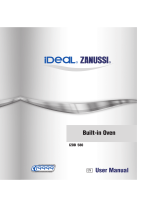
We recommend you wipe the water droplets
away after every cooking process.
Important! Always cook with the oven
door closed.
Always open the oven door carefully. Do not
allow the door to ”fall open”, support the
door using the door handle, until it is fully
open
The oven has four shelf levels.
The shelf positions are counted from the
floor of the oven upwards, as shown in
the figure.
The slide-in components must always
be properly inserted (see figure).
Do not place cookware and pots directly
on the floor of the oven.
Fan forced cooking (hot air)
The food is cooked by means of preheated
air force-blown evenly round the inside of the
oven by a fan set on the rear wall of the oven
itself.
The heat reaches all parts of the oven evenly
and fast. This means that you can simulta-
neously cook different types of food posi-
tioned on the various oven shelves.
The advantages of cooking with this
function are:
–
Faster preheating
As the fan oven quickly reaches tempera-
ture, it is not usually necessary to preheat
the oven although you may find that you
need to allow an extra 5-7 minutes on
cooking times. For recipes which require
higher temperatures, best results are ach-
ieved if the oven is preheated first, e.g.
bread, pastries, scones, souffles, etc.
– Lower temperatures
Fan-assisted cooking generally requires
lower temperatures than conventional
cooking.
Follow the temperatures recommended in
the cooking chart. Remember to reduce
temperatures for top and bottom heat by
about 20-25 ºC for your own conventional
recipes.
–
Even heating for baking
The fan oven has uniform heating on all
shelf positions. This means that batches of
the same food can be cooked in the oven
at the same time. However, the top shelf
may brown slightly quicker than the lower
one.
This is absolutely normal. There is no fla-
vour transference between dishes.
Top and bottom heating element
– The middle shelf position allows for the
best heat distribution. If you want a base
browning, simply place the cakes and pas-
tries on to a lower shelf position in the
oven. To increase top browning, raise the
shelf position.
– The material and finish of the baking trays
and dishes used will affect base browning.
Enamelware, dark, heavy or nonstick uten-
sils increase base browning, while oven
glassware, shiny aluminium or polished
steel trays reflect the heat away and give
less base browning.
– Always place dishes centrally on the shelf
to ensure even browning.
– Stand dishes on suitably sized baking
trays to prevent spillage onto the base of
the oven and make cleaning easier.
–
Do not place dishes, tins or baking
trays directly on the oven base as it be-
comes very hot and damage will occur.
When using this setting, heat comes from
both the top and bottom elements. This
allows you to cook on a single level. This is
particularly suitable for dishes which re-
quire extra base browning such as, e. g.
quiches and flans.
Gratins, lasagne and hotpots which require
extra top browning also cook well in the con-
ventional oven.
How to use heat from above and below:
1. Turn the oven controller to the function
you want
2. Turn the temperature control to the tem-
perature you want.
6 progress



















